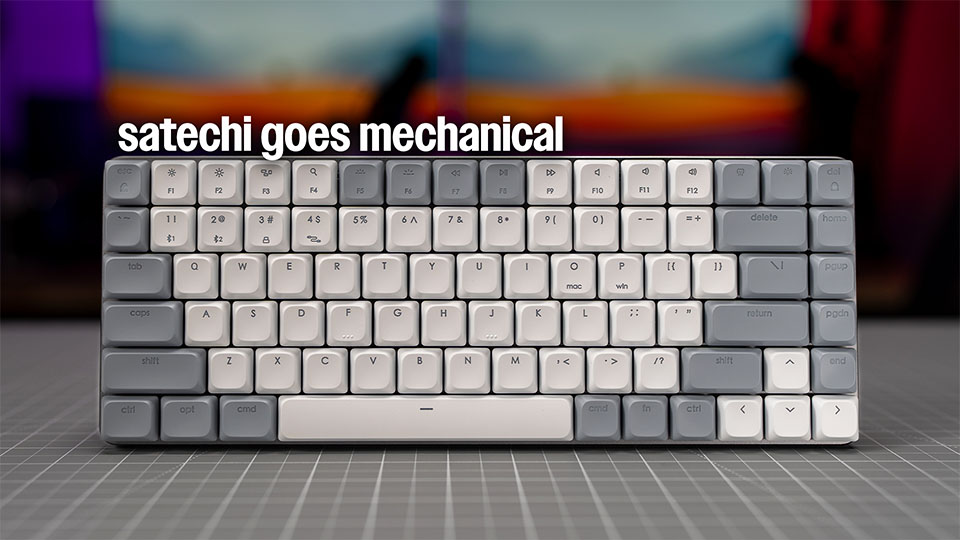Links in this post may be affiliate links. Any products purchased through affiliate links may provide a small commission which helps to support the SemiPro Tech+Gear site and YouTube channel.
Satechi has entered the mechanical keyboard market with the SM1, a 75% low profile mechanical keyboard with tactile switches, wireless connectivity, and WIN/MAC OS compatibility. But can it stand out in a market with fierce competition?
The market for low profile mechanical keyboards has been heating up in the last two years. Satechi is not stranger to keyboards in general, they offer super-low profile options aimed at Mac users as a more affordable alternative to the Apple Magic Keyboard; the X1 is actually quite a nice keyboard if you’re not a fan of mechanical switches and prefer the laptop-style ultra slim keys. But mechanical keyboards are a different animal, and mechanical keyboard enthusiasts (myself included) can be picky about sound, feel, and features. Let’s review how the SM1 stacks up against the top competitors in the 75% low profile space.
Satechi SM1
MSRP: $99 USD
Pros
- Great battery life with backlighting off
- 2.4GHz with storage for receiver
- Can use on top of a laptop
Cons
- Metallic resonance sound is hard to ignore
- Switches are not hot-swappable (and they’re pingy & scratchy)
- Feels less premium than other Satechi products
- No customization options (third party software only)
Best For: Honestly it’s not worth $99 when compared to competitors like the Keychron K3 Max or NuPhy Air75 V2.
The Good
There are some things to like about the SM1. Most significantly, it offers great battery life when the backlighting is turned off. You can use the SM1 for up to two months if you don’t use the lighting, which should equal around 200 hours of use. This is not the best performance amongst competitors (the NuPhy Air75 V2 offers 300+ hours with lights off) but it’s very respectable.
The wireless options are also nice here, with 2.4GHz and a storage slot for the receiver. Satechi doesn’t share the polling rate of the 2.4GHz connection in the specs, but it was a stable connection for me, as was Bluetooth. There are two Bluetooth connections, which is fine, however some competitors offer 3 in addition to the 2.4GHz connection.
The backlighting, while it does significantly reduce battery life, is also nicely implemented. The shine-through legends are pleasantly illuminated even on the lowest setting, allowing you to stretch the battery a little bit. You can also set the SM1 on top of your laptop keyboard if you want to, thanks to Satechi smartly positioning the rubber feet.
I should also point out that while Satechi has been known for making Mac accessories, the SM1 is compatible with both Windows and Mac and there is a simple key command (identified with sub-legends) to swap between modifier key layouts.
Room for Improvement
Unfortunately, my list of “cons” or downsides for the SM1 is a bit longer than the list of positives. And more unfortunately, it’s not entirely because the competition in the market of 75% low profile mechanical keyboards has some excellent offerings at similar prices (which I’ll touch on more in a moment). There are some objective downsides here that wouldn’t be any different in the absence of the competition.
The biggest downside in my opinion is the sound of the SM1. Sound is very subjective, and there are all sorts of sound profiles that one may like or dislike when it comes to mechanical keyboards. But a pingy, metallic resonance is generally not an appealing sound regardless of personal taste. I suspect the ping is coming from the springs in the switches, which are not hot-swappable, and the case is not doing anything to absorb or suppress it. For me, it’s too loud to ignore, but you can decide for yourself by listening to the sound test in the video above.
As I mentioned, the switches are not hot-swappable (they are soldered). This is not a dealbreaker if the switches are high quality and pleasant to type on. However that’s unfortunately not the case here. Aside from the aforementioned pingy sound, they’re also fairly scratchy feeling. Not the worst I’ve ever experienced, but not nearly as smooth as Gateron Low Profile 2.0 Brown switches.
In addition to those issues, I also don’t find the SM1 to have the overall premium feel that I’ve come to expect from Satechi products. I’ve used the X1 keyboard, a USB-C hub, and Thunderbolt cables from Satechi and have found them to have a fairly premium feel that is a step above the average amazon options. However the SM1 to me falls short of “premium”. It feels very lightweight in the hand and the plastic bottom feels like lower quality plastic compared to the competition at similar price points. It does not feel “cheap” per se, just a step below “premium”.
Let’s finish with something less subjective – there is no firmware customization available with the SM1. If you want to remap keys or add macros, you’re relegated to third party software solutions rather than customizing the firmware which allows you to retain your customizations across devices.
So ultimately, I personally find the SM1 hard to recommend for $99. Perhaps if it was priced in the $69-79 range it would be worth it, however we have to consider the competition as I’ve mentioned several times.
The Keychron K3 Max is the closest competitor in terms of look & feel and price. For $114, you not only get a ping-free typing sound, you get RGB lighting, hot-swappable Gateron switches, PBT keycaps, and QMK firmware with VIA compatibility. You also get a third bluetooth connection and 1,000Hz polling rate for the 2.4GHz connection which is enough for gaming use. I would easily select the K3 Max over the SM1, even though the battery life is a bit less (180hrs with lighting off).
For a truly premium feel, the NuPhy Air75 V2 is one of the best low profile 75% mechanical keyboards available. At a price of $119 with Gateron switches or $129 with NuPhy switches (there are seven switch options!), you get all the features mentioned above with the K3 Max including QMK firmware, but an improved sound profile and more premium feel. The Air75 V2 with NuPhy cowberry switches is downright thocky, offering a very satisfying sound and feel that is free of rattles or anything unpleasant.
There are other options as well, including the AZIO Cascade Slim, which I would also place above the SM1, and the Lofree Flow, which is quite a bit more expensive at $169 but much more premium and unique. Any of these options I believe offer a more satisfying typing experience than the SM1. If Satechi ever offers a V2 of the SM1, I’ll be eager to see if it returns to the premium feel that Satechi is known for.
Check out the SM1
Keyboard Specs:
Price: $99 USD
Layout: ANSI 75%
Switch Options: proprietary tactile
Hot-swappable: No
Connectivity: Bluetooth for 2 devices, 2.4GHz, USB-C wired
OS Compatibility: mac/windows
Typing angle: not stated
Frame: Aluminum
Bottom case: ABS
Keycap: ABS shine-through
Dimensions: 308mm x 119mm x 24mm
Weight: 471g / 1.04 lbs
Battery Capacity: 2500mAh


